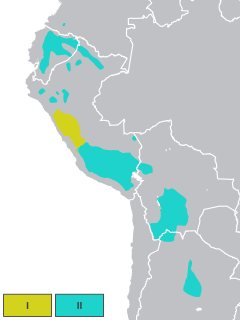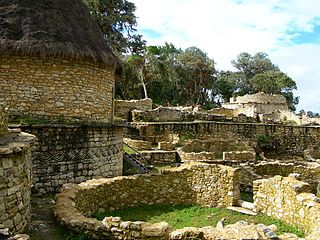Amancay or Amankay is a common name of Quechua origin.

Quechua, usually called Runasimi in Quechuan languages, is an indigenous language family spoken by the Quechua peoples, primarily living in the Peruvian Andes and highlands of South America. Derived from a common ancestral language, it is the most widely spoken language family of indigenous peoples of the Americas, with a total of probably some 8–10 million speakers. Approximately 25% of Peruvians speak a Quechuan language. It is perhaps most widely known for being the main language family of the Inca Empire. The Spanish colonisers initially encouraged its use, but from the middle of their reign they suppressed it. However, Quechua ultimately survived and variants are still widely spoken today.
Yurak amankay (Quechua for 'white lily' [1] ) was occasionally used as a title, with the addition of several more, when referring to the most respected noble ladies of the Inca Empire.

The Inca Empire, also known as the Incan Empire and the Inka Empire, was the largest empire in pre-Columbian America. Its political and administrative structure is considered by most scholars to have been the most developed in the Americas before Columbus' arrival. The administrative, political and military center of the empire was located in the city of Cusco. The Inca civilization arose from the Peruvian highlands sometime in the early 13th century. Its last stronghold was conquered by the Spanish in 1572.
The original denomination for the city of Abancay, capital of the Apurimac region in Peru, is attributed to a princess or "ñusta" of Inca epoch called Amanqay. In essence, the word Abancay comes from a corruption of the Quechua "Hamanqay o Amancaes" (Hemenocallis longipetala). [2]

Abancay is a city in southern-central Peru. It is the capital of both the Apurímac Region and the Abancay Province.

Peru, officially the Republic of Peru, is a country in western South America. It is bordered in the north by Ecuador and Colombia, in the east by Brazil, in the southeast by Bolivia, in the south by Chile, and in the west by the Pacific Ocean. Peru is a megadiverse country with habitats ranging from the arid plains of the Pacific coastal region in the west to the peaks of the Andes mountains vertically extending from the north to the southeast of the country to the tropical Amazon Basin rainforest in the east with the Amazon river.
Amancay may refer to several plants:
- Alstroemeria, which is commonly called Peruvian Lily or Lily of the Incas, in South America, especially
- Lagerstroemia species, which are often called "Amancay" in cultivation.
- Ismene amancaes , which is called Peruvian daffodil or Amancae

Alstroemeria, commonly called the Peruvian lily or lily of the Incas, is a genus of flowering plants in the family Alstroemeriaceae. They are all native to South America although some have become naturalized in the United States, Mexico, Australia, New Zealand, Madeira and the Canary Islands. Almost all of the species are restricted to one of two distinct centers of diversity, one in central Chile, the other in eastern Brazil. Species of Alstroemeria from Chile are winter-growing plants while those of Brazil are summer-growing. All are long-lived perennials except A. graminea, a diminutive annual from the Atacama Desert of Chile.

Alstroemeria patagonica is a species of flowering plant in the family Alstroemeriaceae, native to southern Argentina and southern Chile.

Lagerstroemia, commonly known as crape myrtle or crepe myrtle, is a genus of around 50 species of deciduous and evergreen trees and shrubs native to the Indian subcontinent, southeast Asia, northern Australia, and parts of Oceania, cultivated in warmer climates around the world. It is a member of the family Lythraceae, which are also known as the loosestrife family. The genus is named after the Swedish merchant Magnus von Lagerström, a director of the Swedish East India Company who supplied Carl Linnaeus with plants he collected. These flowering trees are beautifully colored and are often planted both privately and commercially as ornamentals.

Vilcabamba, Willkapampa or Espíritu Pampa was a city founded by Manco Inca in 1539 that served as the capital of the Neo-Inca State, the last refuge of the Inca Empire until it fell to the Spaniards in 1572, signaling the end of Inca resistance to Spanish rule. The city was then destroyed, rediscovered in 1911, and scholars believe it to be the fabled "Lost city of the Incas".

The Chachapoyas, also called the "Warriors of the Clouds", was a culture of the Andes living in the cloud forests of the Amazonas Region of present-day Peru. The Inca Empire conquered their civilization shortly before the Spanish conquest in the 16th century. At the time of the arrival of the conquistadors, the Chachapoyas were one of the many nations ruled by the Incas, although their incorporation had been difficult due to their constant resistance to Inca troops.

Manco Inca Yupanqui was the founder and monarch of the independent Neo-Inca State in Vilcabamba, although he was originally a puppet Inca Emperor installed by the Spaniards. He was also known as "Manco II" and "Manco Cápac II". He was one of the sons of Huayna Capac and a younger brother of Huascar.

Inca Garcilaso de la Vega, born Gómez Suárez de Figueroa and known as El Inca or Inca Garcilaso de la Vega, was a chronicler and writer born in the Spanish Empire's Viceroyalty of Peru. He is considered the first biological mestizo (mixed-race) person in the history of America. Sailing to Spain at 21, he was educated informally there, where he lived and worked the rest of his life. The natural son of a Spanish conquistador and an Inca noblewoman born in the early years of the conquest, he is known primarily for his chronicles of Inca history, culture, and society. His work was widely read in Europe, influential and well received. It was the first literature by an author born in the Americas to enter the western canon.
Amauta was a title for teachers in the Inca empire, especially of children of the nobility.

The Wiphala is a square emblem, commonly used as a flag, representing some native peoples of the Andes that include today's Bolivia, Peru, Ecuador and parts of Argentina, Chile and Colombia.

The Battle of the Maule was fought between a coalition of Mapuche people of Chile and the Inca Empire of Peru. Traditionally this battle is held to have occurred near what is now Maule River, in Central Chile. The account of Garcilaso de la Vega depicts the three-day battle, which is generally believed to have occurred in the reign of Tupac Inca Yupanqui, marked the end of the Incas' southward expansion.
The term Peruvian literature not only refers to literature produced in the independent Republic of Peru, but also to literature produced in the Viceroyalty of Peru during the country's colonial period, and to oral artistic forms created by diverse ethnic groups that existed in the area during the prehispanic period, such as the Quechua, the Aymara and the Chanka South American native groups.

Marco Aurelio Denegri Santagadea was a Peruvian intellectual, literature critic, television host and sexologist.

Rodolfo Cerrón Palomino is a Peruvian linguist who has crucially contributed to the investigation and development of the Quechuan languages. He has also made outstanding contributions to the study of the Aymara, Mochica and Chipaya languages.

The Comentarios Reales de los Incas is a book written by Inca Garcilaso de la Vega, the first published mestizo writer of colonial Andean South America. The Comentarios Reales de los Incas is considered by most to be the unquestioned masterpiece of Inca Garcilaso de la Vega, born of the first generation after the Spanish conquest. He wrote what is arguably the best prose of the colonial period in Peru.
Pedro de Candia was a Greek explorer and cartographer at the service of the Kingdom of Spain, an officer of the Royal Spanish Navy that under the Spanish Crown became a Conquistador, Grandee of Spain, Commander of the Royal Spanish Fleet of the Southern Sea, Colonial Ordinance of Cusco, and then Mayor of Lima between 1534 and 1535. Specialized in the use of firearms and artillery, he was one of the earliers explorers of Panama and the Pacific coastline of Colombia, and finally participated in the conquest of Peru. He was killed in the Battle of Chupas, (Peru), on 16 September 1542, by Diego de Almagro II.

Lake Uspaccocha or Uspaycocha is a lake in the Andes of Peru located in the Apurímac Region, Abancay Province, Abancay District. It is situated in the Ampay National Sanctuary, at 3750 meters above sea level, north of the city of Abancay.
José Antonio Mazzotti is a Peruvian poet, scholar, and literary activist. He is Professor of Latin American Literature and King Felipe VI of Spain Professor of Spanish Culture and Civilization in the Department of Romance Studies at Tufts University, President of the International Association of Peruvianists since 1996, and Director of the Revista de Crítica Literaria Latinoamericana since 2010. He is considered an expert in Latin American colonial literature, especially in El Inca Garcilaso de la Vega and the formation of criollo cultures, a critic of Latin American contemporary poetry, and a prominent member of the Peruvian 1980s literary generation. He received the José Lezama Lima special poetry prize from Casa de las Américas, Cuba, in 2018, for his collection El zorro y la luna. Poemas reunidos, 1981-2016.
Pocras were the ancient Wari culture inhabitants of the modern-day city of Huamanga, Peru before the Spanish conquest of the Inca Empire, bounded on the northwest by the Warivilcas, and on the southeast by the Rucanas and the Soras and on the east by the Mayonmarka near the Andahuaylas in La Mar (Chungui) in the current Peruvian province of Ayacucho. This culture was developed in the Middle Horizon and Late Intermediate cultural periods of Peru, from about CE 500 to 1000. Culturally the Pocras were outstanding in pottery, especially that found in Conchopata, Akuchimay, and behind Los Caballitos on the banks of Piñawa, Tenería or contemporary Alameda.
Mawk'allaqta, also Mawk'a Llaqta is an archaeological site in Peru. It is located in the Arequipa Region, La Unión Province, Puyca District, located about 2 kilometers from Puyca.

Inca rule in Chile was brief; it lasted from the 1470s to the 1530s when the Inca Empire collapsed. The main settlements of the Inca Empire in Chile lay along the Aconcagua, Mapocho and Maipo rivers. Quillota in Aconcagua Valley was likely the Incas' foremost settlement. The bulk of the people conquered by the Incas in Central Chile were Diaguitas and part of the Promaucae.

Historia general de las Indias is the account by Francisco López de Gómara of the Spanish conquest of the Aztec Empire. The first printing was in December 1552, in the workshop of Agustín Millán in Zaragoza, published under the title Primera y segunda parte de la Historia General de las Indias con todo el descubrimiento y cosas notables que han acaecido dende que se ganaron hasta el año de 1551. Con la conquista de México de la Nueva España


















